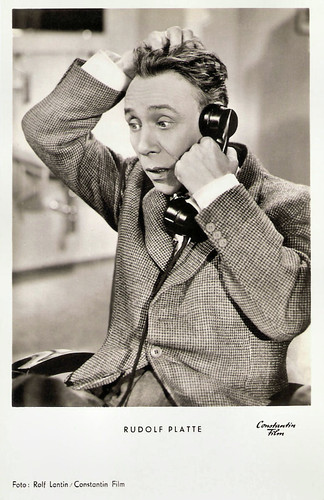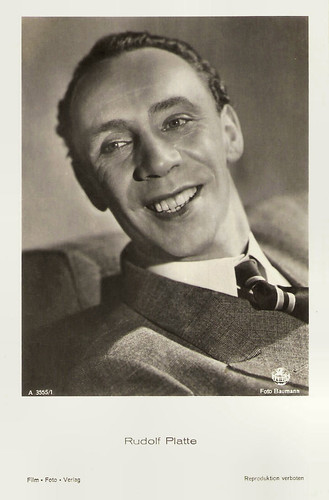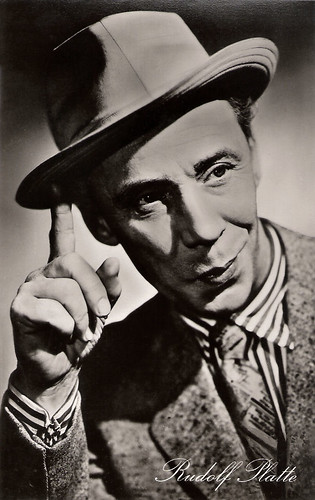German character actor Rudolf Platte (1904-1984) played both cheerfully talkative and reserved and shy, but loving people in more than 200 films. After his death, the media hailed him as Berlin’s ‘last true folk actor’.

German postcard by Kunst und Bild, Berlin. Photo: Rolf Lantin / Constantin-Film.

German postcard by Film-Foto-Verlag, no. A 3555/1, 1941-1944. Photo: Baumann / Terra.
Servants, Postmen and Small-time Crooks
Rudolf Antonius Heinrich Platte was born in Hörde in northern Germany in 1904. He was the son of the merchant Josef Platte and his wife Karoline. When he was three years old, his family moved to Hildesheim. Before his graduation, the 16-years old left school and took acting classes. Despite his young age, he made his stage debut in 1925 as Shylock in Der Kaufmann von Venedig (The Merchant of Venice) by William Shakespeare at the Freilichtbühne Düsseldorf. He gained more experience during engagements in Bad Harzburg, Hildesheim, Hagen, Wuppertal and at the Residenz Theater Hannover. He spent some time at the Lobe-Theater in Breslau (now Wroclaw), where he also directed several productions himself. In 1927 he came to Berlin, where he set up the cabaret 'Die Katakombe' (the catacomb) together with the political satirist, writer, and actor Werner Finck and the actor and director Hans Deppe. Die Katakombe was banned by the Nazis in 1935. His film debut was the youth drama Revolte im Erziehungshaus/Revolt in the Borstal (Georg Asagaroff, 1929) with Carl Balhaus. It was the start of a cinema career with more than 200 films. He often played roles of servants, postmen and small-time crooks: ordinary, reserved and shy, but loving people. German Wikipedia describes his character as ‘Mann von der Strasse’ (man of the street).

German postcard by Rüdel-Verlag. Photo: CCC / Gloria.
Rattling, Clumsy, Or Gloomy And Buffoonish
In the 1930s, Rudolf Platte also appeared in music revues in Berlin. His breakthrough was his performance in the revue Ein Kuß reist um die Welt (A kiss travels around the world) with Hilde Seipp and Aribert Mog. He played minor parts in a range of prestigious films, including F.P.1 antwortet nicht/F.P.1 Doesn't Answer (Karl Hartl, 1932), the cross dressing comedy Viktor und Viktoria/Viktor and Viktoria (Reinhold Schünzel, 1933) featuring Renate Müller, and the Science-fiction film Gold (Karl Hartl, 1934) starring Hans Albers and Brigitte Helm. He also appeared in one of the first Nazi propaganda films, Hitlerjunge Quex/Hitler Youth Quex (Hans Steinhoff, 1933). He was given the title role in Schützenkönig wird der Felix/Bashful Felix (Carl Boese, 1934). Another leading part was his final film role during the Nazi period, the criminologist Bruch in Der Meisterdetektiv/The Master Detective (Ernst Marischka, 1943). Between 1940 and 1944 he was director of the Theater in der Behrenstrasse, and from 1945 to 1947, he headed the Theater an Schiffbauerdamm. As an actor he could play both tragic and comic characters. During the 1950s he showed up in many entertainment films. These include the comedy Pension Schoeller (Georg Jacoby, 1952) starring Camilla Spira, the operetta Die Blume von Hawaii/Flower of Hawaii (Géza von Cziffra, 1953) with Maria Litto, and the comedy Columbus entdeckt Krähwinkel/Columbus Discovers Kraehwinkel (Ulrich Erfurth and Alexander Paal, 1954) starring Eva Kerbler and Charles Chaplin Jr. Filmportal.de: “Platte rarely starred in serious character roles like, for instance, in the role of the Czech refugee in Rolf Thiele’s film Mamitschka (1955) or in the role of 'Herr Wenzel' in Alfred Weidenmann’s film version of Die Buddenbrooks (The Buddenbrooks, 1959). Instead, Platte mainly played rattling, clumsy, or gloomy and buffoonish domestics, vagabonds, or petty crooks in entertainment films like Der Haustyrann (1959). Although these roles were well received by the audience, they did rarely meet his acting talents.”

East-German postcard by VEB Progress Film-Vertrieb, no. 37/332, 1957. Retail price: 0,20 DM. Photo: Real-Film. Publicity still for Die tolle Lola/The great Lola (Hans Deppe, 1954).
Hippie Comedy
In 1964, Rudolf Platte co-starred with Götz George and Hans Nielsen in the war film Herrenpartie/Destination Death (Wolfgang Staudte, 1964) as a book dealer with a Nazi past. It was entered into the 14th Berlin International Film Festival. A curiosity was his leading part in the Dutch-German ‘hippie' comedy Professor Columbus (Rainer Erler, 1968) with Jeroen Krabbé. He rejoined with director Wolfgang Staudte for Die Herren mit der weißen Weste/Gentlemen in White Vests (1970) starring Martin Held. From the 1970s on, he often appeared on TV, both in popular Krimi shows like Der Kommisar/The Commissioner (1972-1975) and Derrick (1975-1977) as in demanding literary adaptations. On stage, Platte became one of Berlin’s most popular folk actors with the play Das Fenster zum Flur (Window to the corridor) by Curt Flatow and Horst Pillau. 278 times, he played his role as a gradually going blind streetcar driver at the Hebbel Theater. In 1982 he played his last film role in Die Sehnsucht der Veronika Voss/Veronika Voss (Rainer Werner Fassbinder, 1982). He played a melancholy Jewish pensioner who commits suicide alongside his wife (Johanna Hofer).Rudolf Platte married four times. His first wife was Vally Hager. Then he was briefly married to actress Georgia Lind. From 1942 till 1953, actress Marina Ried was his third wife. Then he remarried Georgia Lind. Thomas Staedeli at Cyranos: “After the death of Georgia Lind he lost his life courage and died only some days after his wife's death. The newspapers hailed him in 1984 as the ‘last true folk actor’. The childless Plattes bequeathed their combined assets of about two million Mark to the Hermann Gmeiner Fund to promote the SOS Children's Villages.
Sinalco Spot wit Platte. Source: SinalcoDeutschland (YouTube).
Trailer Das Fenster zum Flur Erik Ode, 1960) with Inge Meysel. Source: See Arr (YouTube).
Trailer Ihr schönster Tag (Paul Verhoeven, 1962. Source: See Arr (YouTube).
Sources: Thomas Staedeli (Cyranos), Stephanie d’Heil (Steffi-line) (German), The Concise Cinegraph / Filmportal.de, Wikipedia (German), and IMDb.

German postcard by Kunst und Bild, Berlin. Photo: Rolf Lantin / Constantin-Film.

German postcard by Film-Foto-Verlag, no. A 3555/1, 1941-1944. Photo: Baumann / Terra.
Servants, Postmen and Small-time Crooks
Rudolf Antonius Heinrich Platte was born in Hörde in northern Germany in 1904. He was the son of the merchant Josef Platte and his wife Karoline. When he was three years old, his family moved to Hildesheim. Before his graduation, the 16-years old left school and took acting classes. Despite his young age, he made his stage debut in 1925 as Shylock in Der Kaufmann von Venedig (The Merchant of Venice) by William Shakespeare at the Freilichtbühne Düsseldorf. He gained more experience during engagements in Bad Harzburg, Hildesheim, Hagen, Wuppertal and at the Residenz Theater Hannover. He spent some time at the Lobe-Theater in Breslau (now Wroclaw), where he also directed several productions himself. In 1927 he came to Berlin, where he set up the cabaret 'Die Katakombe' (the catacomb) together with the political satirist, writer, and actor Werner Finck and the actor and director Hans Deppe. Die Katakombe was banned by the Nazis in 1935. His film debut was the youth drama Revolte im Erziehungshaus/Revolt in the Borstal (Georg Asagaroff, 1929) with Carl Balhaus. It was the start of a cinema career with more than 200 films. He often played roles of servants, postmen and small-time crooks: ordinary, reserved and shy, but loving people. German Wikipedia describes his character as ‘Mann von der Strasse’ (man of the street).

German postcard by Rüdel-Verlag. Photo: CCC / Gloria.
Rattling, Clumsy, Or Gloomy And Buffoonish
In the 1930s, Rudolf Platte also appeared in music revues in Berlin. His breakthrough was his performance in the revue Ein Kuß reist um die Welt (A kiss travels around the world) with Hilde Seipp and Aribert Mog. He played minor parts in a range of prestigious films, including F.P.1 antwortet nicht/F.P.1 Doesn't Answer (Karl Hartl, 1932), the cross dressing comedy Viktor und Viktoria/Viktor and Viktoria (Reinhold Schünzel, 1933) featuring Renate Müller, and the Science-fiction film Gold (Karl Hartl, 1934) starring Hans Albers and Brigitte Helm. He also appeared in one of the first Nazi propaganda films, Hitlerjunge Quex/Hitler Youth Quex (Hans Steinhoff, 1933). He was given the title role in Schützenkönig wird der Felix/Bashful Felix (Carl Boese, 1934). Another leading part was his final film role during the Nazi period, the criminologist Bruch in Der Meisterdetektiv/The Master Detective (Ernst Marischka, 1943). Between 1940 and 1944 he was director of the Theater in der Behrenstrasse, and from 1945 to 1947, he headed the Theater an Schiffbauerdamm. As an actor he could play both tragic and comic characters. During the 1950s he showed up in many entertainment films. These include the comedy Pension Schoeller (Georg Jacoby, 1952) starring Camilla Spira, the operetta Die Blume von Hawaii/Flower of Hawaii (Géza von Cziffra, 1953) with Maria Litto, and the comedy Columbus entdeckt Krähwinkel/Columbus Discovers Kraehwinkel (Ulrich Erfurth and Alexander Paal, 1954) starring Eva Kerbler and Charles Chaplin Jr. Filmportal.de: “Platte rarely starred in serious character roles like, for instance, in the role of the Czech refugee in Rolf Thiele’s film Mamitschka (1955) or in the role of 'Herr Wenzel' in Alfred Weidenmann’s film version of Die Buddenbrooks (The Buddenbrooks, 1959). Instead, Platte mainly played rattling, clumsy, or gloomy and buffoonish domestics, vagabonds, or petty crooks in entertainment films like Der Haustyrann (1959). Although these roles were well received by the audience, they did rarely meet his acting talents.”

East-German postcard by VEB Progress Film-Vertrieb, no. 37/332, 1957. Retail price: 0,20 DM. Photo: Real-Film. Publicity still for Die tolle Lola/The great Lola (Hans Deppe, 1954).
Hippie Comedy
In 1964, Rudolf Platte co-starred with Götz George and Hans Nielsen in the war film Herrenpartie/Destination Death (Wolfgang Staudte, 1964) as a book dealer with a Nazi past. It was entered into the 14th Berlin International Film Festival. A curiosity was his leading part in the Dutch-German ‘hippie' comedy Professor Columbus (Rainer Erler, 1968) with Jeroen Krabbé. He rejoined with director Wolfgang Staudte for Die Herren mit der weißen Weste/Gentlemen in White Vests (1970) starring Martin Held. From the 1970s on, he often appeared on TV, both in popular Krimi shows like Der Kommisar/The Commissioner (1972-1975) and Derrick (1975-1977) as in demanding literary adaptations. On stage, Platte became one of Berlin’s most popular folk actors with the play Das Fenster zum Flur (Window to the corridor) by Curt Flatow and Horst Pillau. 278 times, he played his role as a gradually going blind streetcar driver at the Hebbel Theater. In 1982 he played his last film role in Die Sehnsucht der Veronika Voss/Veronika Voss (Rainer Werner Fassbinder, 1982). He played a melancholy Jewish pensioner who commits suicide alongside his wife (Johanna Hofer).Rudolf Platte married four times. His first wife was Vally Hager. Then he was briefly married to actress Georgia Lind. From 1942 till 1953, actress Marina Ried was his third wife. Then he remarried Georgia Lind. Thomas Staedeli at Cyranos: “After the death of Georgia Lind he lost his life courage and died only some days after his wife's death. The newspapers hailed him in 1984 as the ‘last true folk actor’. The childless Plattes bequeathed their combined assets of about two million Mark to the Hermann Gmeiner Fund to promote the SOS Children's Villages.
Sinalco Spot wit Platte. Source: SinalcoDeutschland (YouTube).
Trailer Das Fenster zum Flur Erik Ode, 1960) with Inge Meysel. Source: See Arr (YouTube).
Trailer Ihr schönster Tag (Paul Verhoeven, 1962. Source: See Arr (YouTube).
Sources: Thomas Staedeli (Cyranos), Stephanie d’Heil (Steffi-line) (German), The Concise Cinegraph / Filmportal.de, Wikipedia (German), and IMDb.
No comments:
Post a Comment